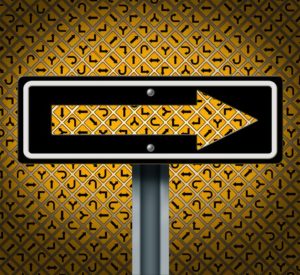By Dr. Ken Broda Bahm:

Both theory and experience say that there are two kinds of thinking. One is focused thinking, zeroing in on a topic, analytically and systematically. The other is diffuse thinking, abstract and constrained only by association or whim. If focused thinking marches across the terrain with destination and purpose, then diffuse thinking drifts over it like a cloud. We tend to value the focused side for work, productivity, learning, and problem-solving, but many thinkers say that diffuse thinking is equally necessary, at least sometimes, in supplying perspective and creativity. This distinction in these two forms, popularized by Oakland University Professor Barbara Oakley, suggests that the adage, “Not all who wander are lost,” applies to minds as well.
A recent short overview published in Farnam Street fleshes out the idea that both modes of thought are common and both are valuable. The legal process, of course, relies most heavily on the focused style of thought. That applies not just to the audience for legal persuasion, a judge or a jury, but also to advocates. In both situations, logical and systematic attention is what we prize. But realistically, audiences might vary: We should be able to expect a judge to have a focused mindset, at least for the first twenty minutes of argument, but on any given jury, it is fair to assume that there are at least a few diffuse listeners in the group. So, in practice, legal persuaders will need to address both: to provide sophisticated and analytical argument to those who are focused on you, and also to provide more thematic and holistic hooks for those who might be thinking more generally. And that need to speak to both styles applies not just to your audiences, but to yourself as well.
Your Jurors’ Focused and Diffuse Thinking
Anyone who has closely watched a jury or, better yet, spoken with them after the trial, understands the reality that some jurors are paying close attention and diving in deeply with your arguments, while others are likely listening, but their attention might be skipping like a rock across the surface. Instead of assuming that you have the former, or complaining about it when you have the latter, the persuasive best practice is to address both.
For the jurors wanting to analyze the evidence and the arguments, point them to it, while “showing your work” with specificity, so they can work their way to their preferred conclusions on their own. And for the jurors who are more diffuse in their thinking, make sure you are providing an effective theme and an overarching story that is as simple as it practically can be. These jurors will also need a heuristic, or a “rule of thumb” that they might apply unconsciously, like “Occam’s Razor,” or the notion that the simpler explanation is more likely to be true.
Your Own Focused and Diffuse Thinking
It isn’t just the jurors or the judge who might have more or less focus. It might also be you at different periods of time. The Farnam Street article describes an ideal mental oscillation: We are focused for a while, to get things done, but then we consciously or unconsciously will take a mental break and step back to put things into perspective.
In the Farnam Street article, the author begins with an evocative description from a Virginia Woolf novel, “As she lost consciousness of outer things…her mind kept throwing up from its depths, scenes, and names, and sayings, and memories and ideas, like a fountain spurting.” The piece shares several historical examples of creative and productive minds who followed that habit.
So as you toil over your case, or over any other difficult work that is on your mind, you will probably find that breaks improve your creative thinking. So you have a good reason to feel less guilt about time spent exercising, listening to music, or driving. You may not be able to bill for it, but it can help in unexpected ways. For example, I find that when I am able to ride my bicycle to or from work, even without having thought about it consciously, I will often have a good idea regarding a case I’m working on, or even an idea for a blog post, after the ride.
______
Other Posts on Thinking Styles:
- See the Threads of Conspiracy Thinking
- Adapt to Information Engagement Styles
- Think About Your Juror’s Epistemology